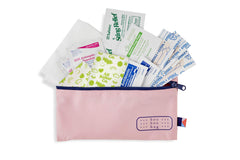Did you know that the U.S. throws away 11.3 MILLION tons of textile waste each year? Hard to imagine? That’s 2,150 pieces per second.
There’s LOTS of talk these days about Sustainability and Sustainable Fashion, but what that means and how we put it into action aren’t always clear. What is clear is that there are things we can do to make a meaningful difference–both as a brand and as consumers.
In the same way we approach nearly everything in life, Kibou is tackling sustainability in fashion in bite-size, actionable pieces.
First things first, we bring to you…
3 Different Approaches to Styling Sustainably:
Look #1: Shopping Sustainable Brands

Skirt - Top - Sneakers - Kibou
Look #2: Renting the Runway, not Owning It - Pants, top + necklace rentable through Rent the Runway Pants - Top - Necklace - Clogs - Kibou
Pants - Top - Necklace - Clogs - Kibou
Look #3: Mix of Sustainable Brands

Skirt - Top - Necklace - Sneakers - Kibou
And now…
A Quick Crash Course on Sustainability in the Fashion Industry…
A working definition:
According to Vogue, Sustainable Fashion is “an umbrella term for clothes that are created and consumed in a way that can be, quite literally, sustained, while protecting both the environment and those producing garments.”
This includes:
- Cutting CO2 emissions
- Addressing overproduction
- Reducing pollution and waste
- Supporting biodiversity
- Ensuring fair wages and safe working conditions for garment workers
Some stats:
- The number of garments produced each year has doubled since 2000
- 87% of garment materials end up as waste
- After gasoline, fashion is the second most polluting industry globally
- 95.2% of fast-fashion brand Shein’s clothing are made from new plastics (and they are not alone!)
- Global Greenhouse Gas emissions from the fashion industry are equivalent to the annual GHG emissions of France, Germany + the United Kingdom combined
- 70% of GHG emissions in fashion come from manufacturing of raw materials (the other 30% from transportation, retail, usage and disposal)
What can we DO?
Setting aside the efforts that we are committed to as a brand (more to come on that soon), here are 6 impactful steps each of us can take as consumers:
- Buy less
- Invest in sustainable brands
- Buy vintage or secondhand
- Rent instead of buy
- Give your clothes a second life
- Avoid plastics and petroleum-based products (like polyester) whenever you can.
What is the bottom line here? 60% of the opportunity to reduce GHG emissions and decrease waste lies in better manufacturing and production practices, but 20% of reduction comes from brands like ours making different choices in our materials sourcing, retail and transportation practices. And whatsmore, a whole 20% relies on us as consumers’ adopting more sustainable practices. So if we want to make a real change, it has to be top down, but it also comes from the bottom up. Rather than throwing our hands up, we find it comforting that each of us has the power to make more sustainable choices that impact our planet.
So, what makes the outfits above more Sustainable?
Kibou retail partner Ave Lumi is one of a growing number of retailers who center their business on Sustainability. After working in corporate fashion, founder Jenny Jackson noted how destructive the industry was on every level, so she opened Ave Lumi with a goal of giving customers access to products that are made ethically and sustainably.
Each Ave Lumi tag comes with a checklist of ways in which your purchase is sustainable:

Jenny’s advice? “Know that every dollar spent really counts; every dollar is a vote for your values.”
 And Rent the Runway?
And Rent the Runway?
While critics contend that their shipping mileage and cleaning practices leave much to be desired, if you’re a person who likes to dress on-trend, then you know that many pieces don’t last beyond a season or two. And in one given season, how often are you likely to wear each piece?
We promise this is not a paid ad, we’re just really big fans of Rent the Runway’s monthly subscription service. It gives you an opportunity to rent 4+ pieces at a time to stay on trend without contributing to the excessive waste that the fashion industry creates each year.
If you fall in love with a piece, you can buy it at a discounted price, but otherwise, you can try multiple new styles each season, sharing them with others and trading them in once you’ve had your fill.
Want to read more? Here are a few really great resources:
Bloomberg Fashion Industry Impact Report




1 comment
It’s astounding to think about the sheer volume of textile waste generated each year, highlighting the urgent need for more sustainable practices in the fashion industry. Taking actionable steps toward sustainability, both as brands and consumers, is crucial to mitigating this issue.
Kibou’s approach of breaking down sustainability into manageable, actionable pieces is commendable. By making sustainable choices more accessible and understandable, they’re empowering both brands and consumers to make meaningful changes.
For those interested in sustainability initiatives, exploring resources like https://diaperrecycling.technology/ can provide valuable insights and solutions. Initiatives like diaper recycling technology not only address specific waste streams but also contribute to a larger conversation about resourcefulness and innovation in sustainability efforts. Thanks for sharing!
Leave a comment